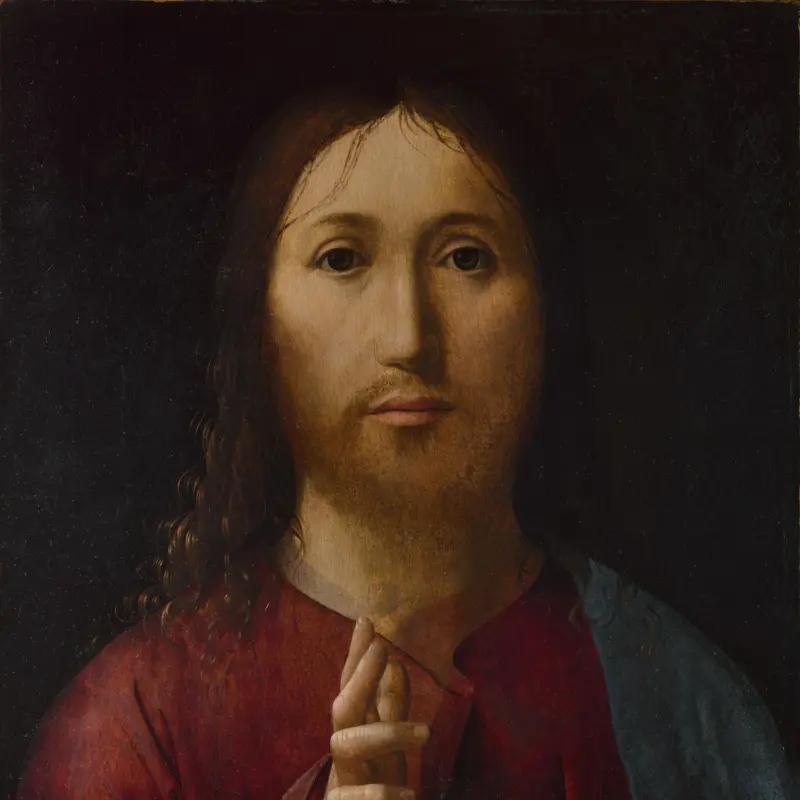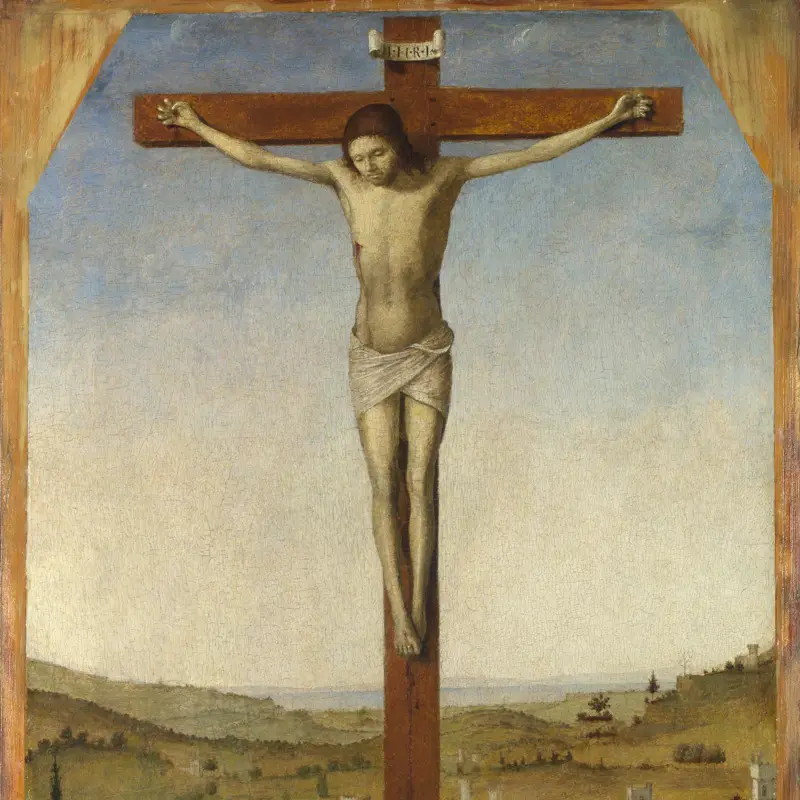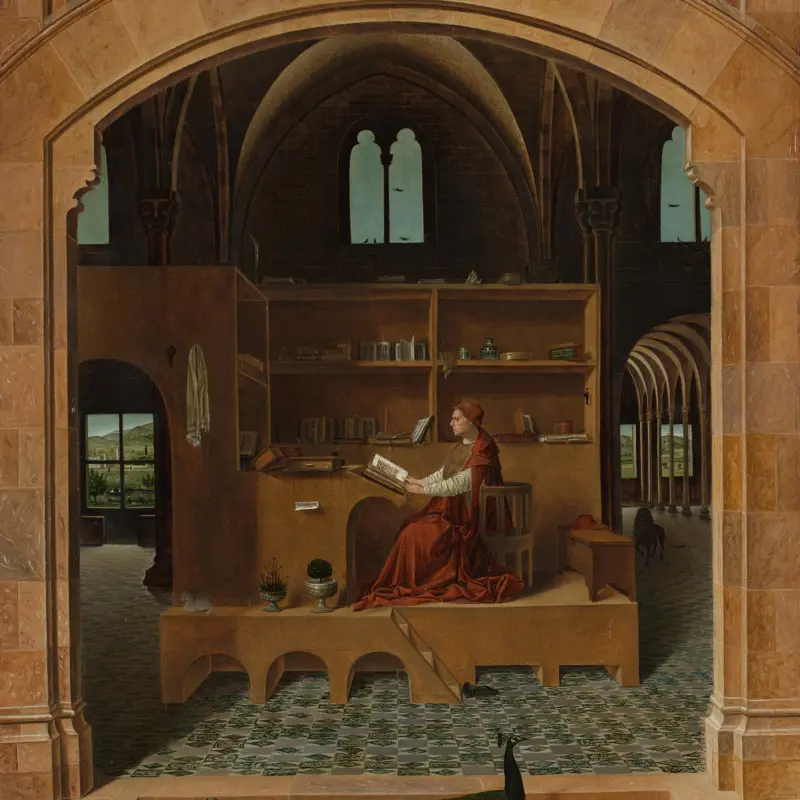Possibly by Antonello da Messina, 'The Virgin and Child', about 1460-9
About the work
Overview
The Virgin Mary glances down at her baby son, Christ, who clutches a pomegranate in his tiny fist. The fruit, with its blood-red juice, was a reminder of the torture and death he would face at the Crucifixion.
Mary was also known as the Queen of Heaven, and her coronation by Christ was a popular subject in Renaissance painting. Here, two tiny hovering angels place a solid gold crown encrusted with pearls and gemstones upon her head. The crown’s magnificence matches that of her brocade gown, jewelled cloak and translucent veil.
The excess of decorative detail reflects paintings by fifteenth-century Netherlandish artists who relished depicting a variety of textures and finishes accurately, something enabled through their great skill at painting using oil. Our painting is certainly by an artist hoping to evoke the style of his Northern European counterparts.
Key facts
Details
- Full title
- The Virgin and Child
- Artist
- Possibly by Antonello da Messina
- Artist dates
- active 1456; died 1479
- Date made
- about 1460-9
- Medium and support
- oil on wood
- Dimensions
- 43.2 × 34.3 cm
- Acquisition credit
- Salting Bequest, 1910
- Inventory number
- NG2618
- Location
- Room 64
- Collection
- Main Collection
- Previous owners
- Frame
- 20th-century Replica Frame
Provenance
Additional information
Text extracted from the ‘Provenance’ section of the catalogue entry in Martin Davies, ‘National Gallery Catalogues: The Earlier Italian Schools’, London 1986; for further information, see the full catalogue entry.
Exhibition history
-
2016Sicily: Culture and ConquestThe British Museum21 April 2016 - 14 August 2016
Bibliography
-
1904Burlington Fine Arts Club, Catalogue of a Collection of Pictures, Decorative Furniture, and other Works of Art, Winter Exhibition (exh. cat. Burlington Fine Arts Club, 1904), London 1904
-
1905H.F. Cook, 'Esposizione al Burlington Fine Arts Club', L'arte, VIII, 1905
-
1910Thomas Agnew & Sons, Catalogue of the Collection of Pictures and Drawings of the Late Mr George Salting, London 1910
-
1910London, National Gallery Archive, NG17/6 ANNUAL REPORTS 1898-1910: Annual Report of the National Gallery for 1910, 1910
-
1912National Gallery, The National Gallery Illustrated Catalogue, London 1912
-
1913National Gallery, Descriptive and Historical Catalogue of the British and Foreign Pictures, 81st edn, London 1913
-
1913B. Berenson, 'Une Madone d'Antonello de Messine', Gazette des beaux-arts, I, 1913, pp. 189-203
-
1916B. Berenson, Venetian Painting in America, New York 1916
-
1919B. Berenson, Dipinti Veneziani in America, Milan 1919
-
1920National Gallery, National Gallery: Catalogue of the Pictures at Trafalgar Square, London 1920
-
1933J. Lauts, 'Antonello da Messina', Jahrbuch der Kunsthistorischen Sammlungen in Wien, VII, 1933, pp. 15-88
-
1937S. Bottari, 'Il primo Antonello', Critica d'arte, II, 1937, pp. 97-109
-
1939S. Bottari, Antonello da Messina, Milan 1939
-
1950G. Fiocco, 'Colantonio ed Antonello', Emporium, CXI/662, 1950, pp. 50-66
-
1951Davies, Martin, National Gallery Catalogues: The Earlier Italian Schools, London 1951
-
1951R. Pallucchini, 'Cataloghi', Arte veneta, V/17-20, 1951, pp. 194-7
-
1952G. Vigni, Tutta la pittura di Antonello da Messina, Milan 1952
-
1953S. Bottari, Antonello, Milan 1953
-
1953M. Davies, 'The Antonello Exhibition at Messina', The Burlington Magazine, XCV/603, 1953, pp. 207-9
-
1953J. Lauts, 'Zur Austellung "Antonello da Messina e la pittura del '400 in Sicilia"', Kunstchronik, VI/6, 1953, pp. 150-62
-
1953R. Longhi, 'Frammento siciliano', Paragone, 47, 1953, pp. 3-44
-
1954S. Bottari, La pittura del Quattrocento in Sicilia, Messina 1954
-
1955S. Bottari, Antonello da Messina, Milan 1955
-
1957B. Berenson, Italian Pictures of the Renaissance: A List of the Principal Artists and Their Works, with an Index of Places: Venetian School, 2 vols, London 1957
-
1957F. Zeri, 'Un riflesso di Antonello da Messina a Firenze', Paragone, XCIX, 1957, pp. 16-21
-
1961M. Davies, The Earlier Italian Schools, 2nd edn, London 1961
-
1964R. Causa, Antonello da Messina, Milan 1964
-
1967L. Sciascia, L'opera completa di Antonello da Messina, Milan 1967
-
1976F. Zeri, 'Aggiunte a Donato de' Bardi', in F. Zeri, Diari di lavoro, Torino 1976, vol. 2
-
1977F. Bologna, Napoli e le rotte mediterranee della pittura: Da Alfonso il Magnanimo a Ferdinando il Cattolico, Naples 1977
-
1979M.G. Paolini, 'Antonello e la sua scuola', in Storia della Sicilia, Naples 1979, vol. 5
-
1981A. Marabottini and F.S. Santoro, Antonello da Messina, (exh. cat. Museo Regionale, 22 October 1981 - 31 January 1982), Rome 1981
-
1982P.H. Jolly, Jan van Eyck and St. Jerome: A Study of Eyckian Influence on Colantonio and Antonello Da Messina in Quattrocento Naples, London 1982
-
1982P.H. Jolly, 'On the Meaning of the Virgin Mary Reading Attributed to Antonello da Messina', Journal of the Walters Art Gallery, XL, 1982, pp. 25-35
-
1983M. Levey, The Neglected National Gallery: An Exhibition of Paintings from the Lower Floor (exh. cat. The National Gallery, 20 April - 31 May 1983), London 1983
-
1984L.C. Vegas, Italie et Flandres dans la peinture du XVe siècle, Milan 1984
-
1986Davies, Martin, National Gallery Catalogues: The Earlier Italian Schools, revised edn, London 1986
-
1986F. Sricchia Santoro, Antonello e l'Europa, Milan 1986
-
1987F. Zeri, La pittura in Italia: Il Quattrocento, Milan 1987
-
1991J. Dunkerton et al., Giotto to Dürer: Early Renaissance Painting in the National Gallery, New Haven 1991
-
1993L. Arbace, Antonello da Messina: Catalogo completo dei dipinti, Florence 1993
-
1993D. Thiébaut, Le Christ à la Colonne d'Antonello de Messine (exh. cat. Musée du Louvre, 13 May - 9 August 1993), Paris 1993
-
1996L.C. Vegas, Il Quattrocento: L'arte del Rinascimento, Milan 1996
-
1996J. Wright, 'Antonello da Messina', in J. Turner (ed.), The Dictionary of Art, London 1996, vol. 2, pp. 178-83
-
1999P. Reuterswärd, 'A Plea for Antonello's London Madonna', Artibus et historiae, 40, 1999, pp. 71-6
-
2000J. Dunkerton, 'Antonello da Messina e la tecnica fiamminga', in F. Simonetti (ed.), Ecce Homo: Antonello da Messina, Genoa 2000, pp. 26-32
-
2001
C. Baker and T. Henry, The National Gallery: Complete Illustrated Catalogue, London 2001
-
2006L. Syson, 'Antonello da Messina', The Burlington Magazine, CXLVIII/1241, 2006, pp. 541-4
-
2006M. Lucco (ed.), Antonello da Messina: L'opera completa (exh. cat. Scuderie del Quirinale, 18 March - 5 June 2006), Milan 2006
About this record
If you know more about this work or have spotted an error, please contact us. Please note that exhibition histories are listed from 2009 onwards. Bibliographies may not be complete; more comprehensive information is available in the National Gallery Library.




